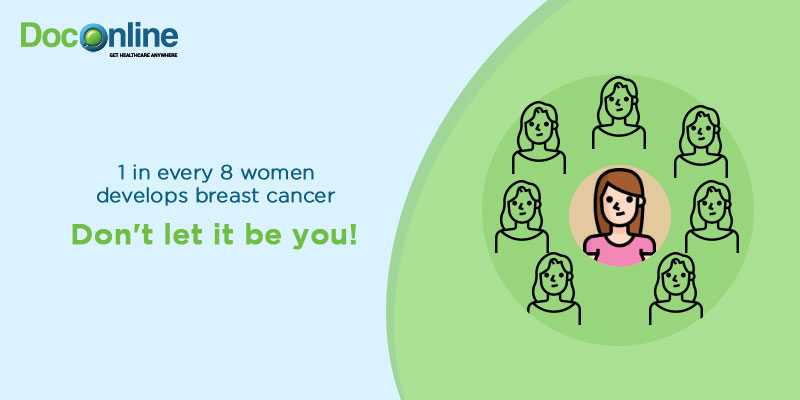Dont assume it can't happen to you….
Globally, in every 19 seconds, a woman is diagnosed with this deadly cancer and a woman dies of it in every 60 seconds. In India, it is the most common cancer among women with an age incidence starting at 10 yrs.
Yes, you’ve guessed it right! We are talking about Breast Cancer. You’ll be surprised to know that 70% of women who get breast cancer don’t have any identifiable risk.
So, what is to be done?
Let us understand the basics - the what, why and how of breast cancer!
Spreading awareness holds the key. By learning more about the illness, one can arrest it at its early stages and undergo proper treatment.
What is Breast Cancer?
Breast cancer is a disease where cells in the breast tissue divide and grow abnormally. The normal control of cell-division is lost. The cells can invade and damage the normal tissue. It is to be noted that breast cancer can start in any part of the breast.
So, who all are at risk?
1. Both females and males. It is surprising to know that although females are more prone to getting breast cancer, it is also found to occur in men.
2. Family history can also dictate if one can develop breast cancer or not. Based on a family history of having breast cancer, about 5% to 10% of breast cancer cases are thought to be hereditary. These are caused by gene changes (mutations) that are inherited from a parent. Inherited mutations in BRCA1 or BRCA2 are the most common cause of hereditary breast cancer.
3. Obese people. Being overweight or obese after menopause is also a potential cause for the incubation of the disease. It results in more oestrogen formation.
4. Nulliparous women or women who have never given birth to babies also run the risk of developing breast cancer. These are females who have either never had any children or, if at all they did, they did so in their thirties or at an older age.
5. Menopausal on treatment: If a lady has menopause at 55 or above and takes Hormone Replacement Therapy (HRT), then she is likely to contract breast cancer.
6. Unhealthy life style with no physical activity and excessive consumption of alcohol can also precipitate it.
What to do if you are at high risk?
Regular screening is essential. The term ‘screening’ means looking for early breast cancer detection signs even before the person shows any symptoms. This can help find cancer at an early stage. When abnormal tissue or cancer is found early, it may be easier to treat. This is important because by the time symptoms appear, cancer may have begun to spread.
The different screening methods that one should know about:
1. Self-Examination of Breast: It is important to do a monthly self-examination of the breast. It should be a part of the monthly health care routine and one should visit a doctor if any changes are found. This should be done regularly post menstrual days when the breasts are least likely to be swollen or enlarged. One should look for the following symptoms:
- - Lump or thickening of the breast
- - Changes in the skin or the nipple
- - A rash around or on one of the nipples.
- - Pitting or redness around the breast, like skin of orange
- - Discharge from the nipple
- - Peeling scaling or flaking of the skin around nipple.
The Breast Self-Examination should, at first, be done while standing and looking straight into the mirror. Next, it should be done lying down on the bed; and lastly, after lying down one should raise the arm above the head.
2. Mammogram: It is the Xray of breast tissue. Although this may be uncomfortable for a moment, but squeezing is necessary to get a good "readable" mammogram. The compression only lasts a few seconds. This procedure produces a picture of the breast tissue either on a large sheet of film or as a digital computer image that is read or interpreted by a radiologist. Mammograms can miss some cancers. However, despite their limitations, they remain very effective and are considered valuable tools for decreasing suffering and death from breast cancer.
ACS screening guidelines recommend annual mammography for females in the age group of 40-44 years.
If there are risk factors in the family history, then one should go for mammogram twice a year.
3. MRI: This is usually done in women who have a lifetime risk of 15% to 20%.For women with high risk of breast cancer, both MRI and mammogram examinations of the breast are recommended.
What prevention methods to adopt?
A change in lifestyle helps. This would include
- - Weight control
- - Active lifestyle
- - Avoiding alcohol
- - Maintaining BMI (Body Mass Index)
- - Eating more of fruits and vegetables
Preventive surgery is also an option for women at risks. It is to be noted that with early screening and diagnosis, breast cancer can be cured completely. Death rates, resulting from breast cancer have been declining since 1990. This has been in part due to better screening and early detection, coupled with increased awareness and continuously improving treatment options. In case of any doubt during self examination, do not hesitate to ask a doctor online or in person for clarification.
So, be alert and spread the awareness regarding Breast cancer!













